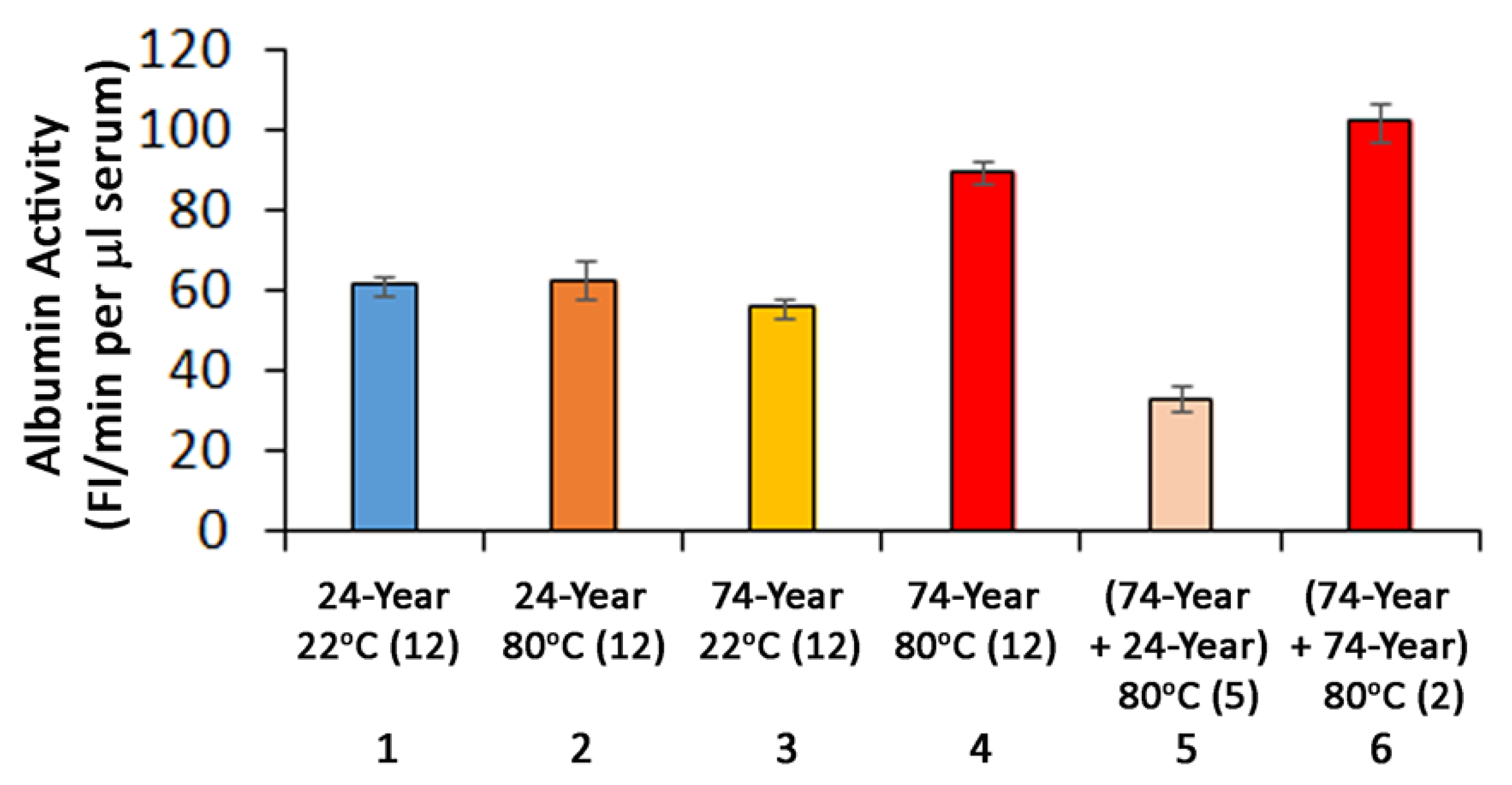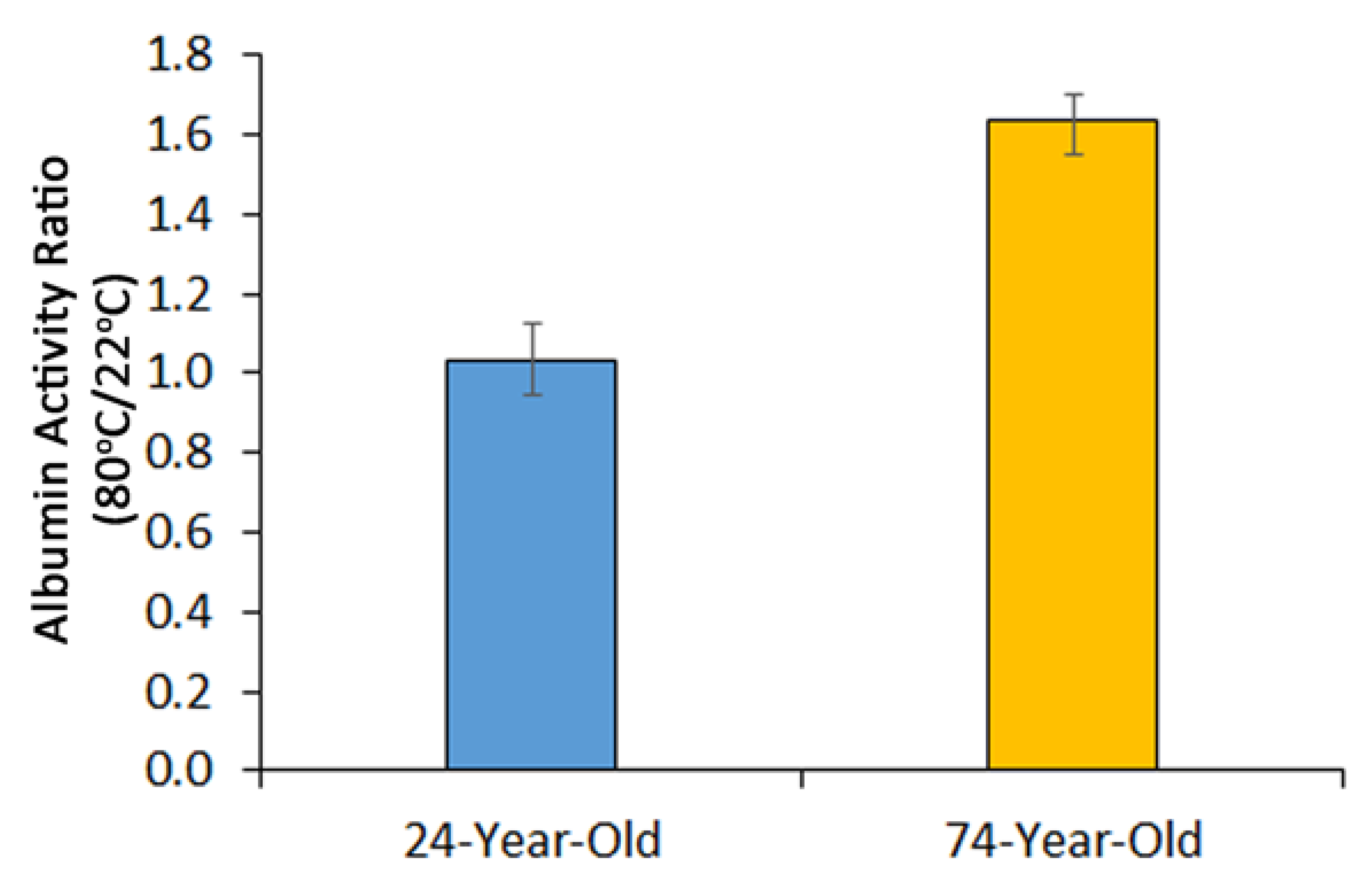Human Serum Albumin Misfolding in Aging and Disease
Abstract
1. Introduction
2. Results
3. Discussion
4. Materials and Methods
Author Contributions
Funding
Institutional Review Board Statement
Informed Consent Statement
Data Availability Statement
Conflicts of Interest
References
- Nicholson, J.P.; Wolmarans, M.R.; Park, G.R. The role of albumin in critical illness. Br. J. Anaesth. 2000, 85, 599–610. [Google Scholar] [CrossRef] [PubMed]
- Doweiko, J.P.; Nompleggi, D.J. The role of albumin in human physiology and pathophysiology, Part III: Albumin and disease states. J. Parenter. Enteral. Nutr. 1991, 15, 476–483. [Google Scholar] [CrossRef] [PubMed]
- Curry, S.; Brick, P.; Franks, N.P. Fatty acid binding to human serum albumin: New insights from crystallographic studies. Biochim. Biophy. Acta. 1999, 1441, 131–140. [Google Scholar] [CrossRef]
- Stefani, M. Protein misfolding and aggregation: New examples in medicine and biology of the dark side of the protein world. Biochim. Biophy. Acta. 2004, 1739, 5–25. [Google Scholar] [CrossRef] [PubMed]
- Hartl, F.U. Protein misfolding diseases. Annu. Rev. Biochem. 2017, 86, 21–26. [Google Scholar] [CrossRef]
- Lindner, A.B.; Demarez, A. Protein aggregation as a paradigm of aging. Biochim. Biophy. Acta. 2009, 1790, 980–996. [Google Scholar] [CrossRef] [PubMed]
- David, D.C. Aging and the aggregating proteome. Front. Genet. 2012, 3, 1–6. [Google Scholar] [CrossRef] [PubMed]
- Meade, R.M.; Fairlie, D.P.; Mason, J.M. Alpha-synuclein structure and Parkinson’s disease–lessons and emerging principles. Mol. Neurodegener. 2019, 14, 29. [Google Scholar] [CrossRef] [PubMed]
- Querfurth, H.W.; LaFerla, F.M. Alzheimer’s disease. N. Engl. J. Med. 2010, 362, 329–344. [Google Scholar] [CrossRef] [PubMed]
- Pandey, N.K.; Ghosh, S.; Dasgupta, S. Fibrillation in human serum albumin is enhanced in the presence of copper(II). J. Phys. Chem. B. 2010, 114, 10228–10233. [Google Scholar] [CrossRef]
- Tsao, F.H.C.; Xiang, Z.; Meyer, K.C. Fluorescent Determination of Secretory Phospholipase A2 (sPLA2)-Mediated Human Serum Albumin Binding Activity with Membrane Phospholipids and Fatty Acids. Transla. Med. 2015, 5, 1–9. [Google Scholar]
- Tsao, F.H.C.; Shanmuganayagam, D.; Zachman, D.K.; Khosravi, M.; Folts, J.D.; Meyer, K.C. A continuous fluorescence assay for the determination of calcium-dependent secretory phospholipase A2 activity in serum. Clin. Chim. Acta 2007, 379, 119–126. [Google Scholar] [CrossRef] [PubMed]
- Tsao, F.H.C.; Culver, B.J.; Pierre, J.F.; Shanmuganayagam, D.; Patten, C.C., Jr.; Meyer, K.C. Prophylactic supplementation of grape polyphenolics attenuates endotoxin-induced serum secretory phospholipase A2 Activity in rats. Comp. Med. 2012, 62, 271–278. [Google Scholar] [PubMed]
- Tsao, F.H.C.; Li, Z.H.; Amessoudji, A.W.; Jawdat, D.; Sadat, M.; Yaseen Arabi, Y.; Meyer, K.C. The Role of Serum Secretory Phospholipase A2 and Albumin in Systemic Inflammation in Sepsis. J. Sepsis. Blood Infect. 2022, 01, 18–30. [Google Scholar]
- Tsao, F.H.C.; Barnes, J.N.; Amessoudji, A.; Li, Z.H.; Meyer, K.C. Aging-related and gender specific albumin misfolding in Alzheimer’s disease. J. Alzheimer’s Dis. Rep. 2020, 4, 67–77. [Google Scholar] [CrossRef] [PubMed]
- Wetzel, R.; Becker, M.; Behlke, J.; Billwitz, H.; Bohm, S.; Ebert, B.; Hamann, H.; Krumbiegel, J.; Lassmann, G. Temperature behaviour of human serum albumin. Eur. J. Biochem. 1980, 104, 469–478. [Google Scholar] [CrossRef] [PubMed]
- Stirpe, A.; Pantusa, M.; Rizzuti, B.; Sportelli, L.; Bartucci, R.; Guzzi, R. Early stage aggregation of human serum albumin in the presence of metal ions. Int. J. Biol. Macromol. 2011, 49, 337–342. [Google Scholar] [CrossRef] [PubMed]
- Scheinost, J.C.; Witter, D.P.; Boldt, G.E.; Wentworth, P. Role of Oxidative Stress in Protein Misfolding and/or Amyloid Formation. In Protein Misfolding Diseases: Current and Emerging Principles and Therapies; Ramirez-Alvarado, M., Kelly, J.W., Dobson, C.M., Eds.; John Wiley & Sons, Inc.: Hoboken, NJ, USA, 2010; pp. 615–630. [Google Scholar]


Publisher’s Note: MDPI stays neutral with regard to jurisdictional claims in published maps and institutional affiliations. |
© 2022 by the authors. Licensee MDPI, Basel, Switzerland. This article is an open access article distributed under the terms and conditions of the Creative Commons Attribution (CC BY) license (https://creativecommons.org/licenses/by/4.0/).
Share and Cite
Tsao, F.H.C.; Meyer, K.C. Human Serum Albumin Misfolding in Aging and Disease. Int. J. Mol. Sci. 2022, 23, 11675. https://doi.org/10.3390/ijms231911675
Tsao FHC, Meyer KC. Human Serum Albumin Misfolding in Aging and Disease. International Journal of Molecular Sciences. 2022; 23(19):11675. https://doi.org/10.3390/ijms231911675
Chicago/Turabian StyleTsao, Francis H. C., and Keith C. Meyer. 2022. "Human Serum Albumin Misfolding in Aging and Disease" International Journal of Molecular Sciences 23, no. 19: 11675. https://doi.org/10.3390/ijms231911675
APA StyleTsao, F. H. C., & Meyer, K. C. (2022). Human Serum Albumin Misfolding in Aging and Disease. International Journal of Molecular Sciences, 23(19), 11675. https://doi.org/10.3390/ijms231911675



